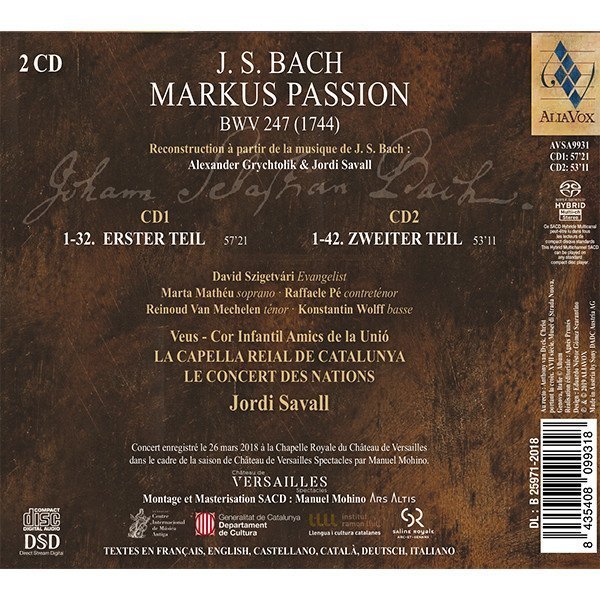J.S. BACH
Markus Passion
Jordi Savall, La Capella Reial de Catalunya, Le Concert des Nations
21,99€
AVSA9931 – J.S Bach Markus Passion
The existence of a third Passion by Bach based on the Gospel of St. Mark had long been known. Numerous studies carried out from the second half of the 20th century by specialist musicologists and musicians confirmed that on Good Friday, 1731, Bach presented this Passion set to a text by Picander, which the latter published one year later at the same time as his third volume of poetry. In 2009, the existence of this Passion was fully confirmed by the discovery at St. Petersburg of a later version of the libretto used for a new performance of the work, which took place in 1744. Compared with the 1732 libretto, it contains a number of modifications to the texts, as well as a different ordering of some chorales and arias and the addition of two new arias. Thanks to the new version, we have a very clear idea of the form and content of this third Passion by Bach.
JOHANN SEBASTIAN BACH
(1685-1750)
St. Mark Passion (BWV 247)
Picander’s 1732 libretto. Final version of the 1744 libretto
Complete revision by Jordi Savall on the basis of research, reconstructions and adaptations for the choruses and recitatives proposed by Alexander Grychtolik
The existence of a third Passion by Bach based on the Gospel of St. Mark had long been known. Numerous studies carried out from the second half of the 20th century by specialist musicologists and musicians confirmed that on Good Friday, 1731, Bach presented this Passion set to a text by Picander, which the latter published one year later at the same time as his third volume of poetry. In 2009, the existence of this Passion was fully confirmed by the discovery at St. Petersburg of a later version of the libretto used for a new performance of the work, which took place in 1744. Compared with the 1732 libretto, it contains a number of modifications to the texts, as well as a different ordering of some chorales and arias and the addition of two new arias. Thanks to the new version, we have a very clear idea of the form and content of this third Passion by Bach.
Unfortunately, so far no trace has been found of the original music. No manuscript score, copy or part-books provide evidence that it actually existed. It is disturbing that so much music should have disappeared, especially in the case of a great composer like Bach. However, it is now possible to account for this troubling mystery: after many years of research, most historians and musicologists specialising in the composer’s work agree that Bach probably conceived and performed the work using the pasticcio or parody technique. This was a system used by Bach on numerous occasions, which allowed him to achieve a different result by adapting new texts to other previously existing works of a similarly spiritual nature.
+ information in the CD booklet
JORDI SAVALL
Perth, 16th February, 2018
Translated by Jacqueline Minett
Critics
”
”l’eccellente Capella Reial de Catalunya dà prova di rigore esecutivo, non disgiunto da un colore nel contempo partecipe alla profondità umana e divina della passione unito a uno slancio drammatico sempre presente ma contenuto nei limiti della compostezza”
Operaclick, Daniela Goldoni
”
”The choir of 25 (including children on the upper parts) and Le Concert des Nations produce a vivid performance in which emotional directness is paramount. “
Gramophone
”
"Fantastische solisten"
Avotros
”
"Qualsiasi cosa toccasse, diventava unica, come le diverse versioni delle sue Passioni, e se ne fosse arrivata a noi una sola, la considereremmo comunque il capolavoro che è. Ed è questo il sigillo apposto Savall alla sua magistrale interpretazione."
Avvenire, Andrea Milanesi








Share